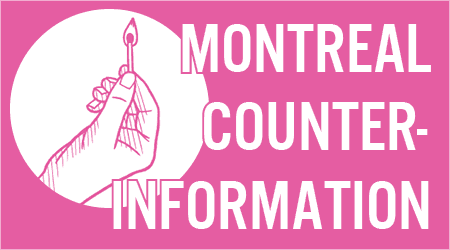
Anonymous submission to MTL Counter-info
Sunday, August 10th was the second annual edition of Rad Pride. Over 250 people gathered at Papineau metro, pink balaclavas mingling with black bloc and our gayest demo attire. Under the rallying cries of “No pride in genocide” and “Queerness is resistance”, the march set off down Sainte-Catherine. Now, a couple weeks later, we want to offer a look back at this evening from a tactical perspective.
On Side Banners
The conflict between reinforced side banners and “side cops” has become a mainstay of combative Montreal demonstrations. Montreal’s reinforced banners are banners with a wooden frame, held by screwed in door-handles, used to protect against riot cop charges and hits by police batons. Over the summer, with terrasses and crowds often obstructing the sidewalks, the cops have apparently received orders to enter the street alongside marching protesters. It is essential to show the cops that this provocation is a grave error. A multiplication of reinforced side banner teams may be one of the best responses, but where these teams position themselves and how others in the crowd complement them are important to consider.
At Rad Pride, a single reinforced side banner took a position at the front, left corner of the march, and it rapidly escalated into a confrontation. After side cops began pushing the banner and banner holders refused to yield, cops ended up squeezed against a low terrasse wall. They began striking people with batons. One demo participants’ flagpole was used to strike a cop in the head from behind the banner. Unfortunately, the position of the side banner at the front made it easy to cut it off from the rest of the crowd, and with enough pepper spray and baton blows, the group around the side banner had to disperse in a chaotic melee that flipped several tables on a terrasse and led to two arrests.
The decision to not move the reinforced banner with more fluidity led to entrenched positions by both anarchists, on one side of the banner, and police, on the other. A tug of war ensued. In such a stubborn situation, one side will be pushed back and have their position compromised. It may have been possible to flank the police on all sides as cops concentrated their forces on pushing back the banner. But without the determination, numbers, or abilities to use entrenched positions to our advantage, we will often benefit much more from encouraging a reinforced banner to move with more freedom, not committed to any specific place in the demonstration (especially the front or back where it is the most isolated). This approach complements one of the main advantages of street fighters versus an enemy as powerful as the police – the ability for militants to attack and retreat, to use the element of surprise, dispersing and reforming.
A Headless March
The SPVM might have hoped that the attack on the front of the march would result in the whole crowd dispersing, but they had a long night still ahead of them. More experienced protesters improvised a new front banner team, encouraged the crowd to stick together, and quickly looped back onto Sainte-Catherine.
It was evident that the SPVM wanted to avoid the PR nightmare of tear-gassing crowds of party-goers in the Gay Village during Pride. Since these crowds were heavily concentrated on Sainte-Catherine, the demo was able to avoid dispersal by staying on that street. On multiple occasions, riot cops formed lines blocking our way forward and to the south; each time, rather than turn north off Sainte-Catherine, the demo turned on its heels and reversed, with multiple banners able to swap in as the new lead.
This game of ping-pong gave demonstrators multiple occasions to take action against the handful of targets along our route. Windows were smashed at RBC, BMO, a Remax office, and Starbucks. The latter was attacked repeatedly on at least three separate passes of the crowd. After the early clash, it took the cops close to half an hour to re-establish flanking side units, showing us that an openly confrontational element in the crowd can function as a diversion, creating space and time for groups oriented more towards destruction.
As the night went on, the vibe became increasingly more festive. Towards 11pm, the demo had become a dance party of still over a hundred people, as a line of fully-geared riot police looked on. Making a laughingstock of the authorities is a calling card of successful mass resistance movements throughout history, and we certainly shouldn’t write off the potential of making the SPVM in particular look ridiculous. The night’s victory was topped off when the riot cops retreated and returned to their vans, and the crowd sang “We Are the Champions”.
This type of conclusion is simply extremely rare for destructive demonstrations in this city. It is the result first and foremost of the determination and fearlessness of participants.


